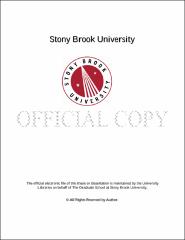| dc.identifier.uri | http://hdl.handle.net/11401/77027 | |
| dc.description.sponsorship | This work is sponsored by the Stony Brook University Graduate School in compliance with the requirements for completion of degree. | en_US |
| dc.format | Monograph | |
| dc.format.medium | Electronic Resource | en_US |
| dc.language.iso | en_US | |
| dc.publisher | The Graduate School, Stony Brook University: Stony Brook, NY. | |
| dc.type | Dissertation | |
| dcterms.abstract | Acrosomal exocytosis (AE) in spermatozoa is a prerequisite for successful mammalian fertilization. However, the molecular mechanism of AE activation is still poorly understood. Mouse egg zona pellucida (ZP) terminal carbohydrate motifs are one of the primary inducers of AE. Previous studies in Sampson’s group have employed ring-opening metathesis polymerization (ROMP) to synthesize polynorbornyl backbone homopolymers displaying sugar moieties to mimic the ZP terminal sugars. Polymers displaying mannose, fucose and GlcNAc are three effective inducers and each carbohydrate is proposed to have a distinct binding site on the sperm cell surface. In order to better reflect the complexity of the heterogeneous display of the ZP carbohydrates, different polymeric architectures have been designed with variations in polymer backbone flexibility, inter-ligand spacing, ligand density, and formation of “multidomain†structures. Glycopolymers with the more flexible cyclooctene backbone were synthesized via ROMP in order to define polymer backbone requirements for activation of mouse sperm AE. To confirm the different flexibilities of norbornene (NB) and cyclooctene (COE) backbones, the conformations of glycopolymers in their aqueous solution state were characterized by small angle X-ray scattering (SAXS). Poly(NB)s form rigid or flexible cylinders. However, poly(COE)s demonstrate much more flexbility than poly(NB)s and form random coils or collapsed strucutres. Furthermore, the efficacy of polymers to activate AE were determined through a triple-stain flow cytometry method. The results revealed that poly(COE)s displaying fucose and GlcNAc were less effective inducers of AE in comparison to their norbornene backbone counterparts. Whereas, poly(COE)s with mannose polymers were the most effective AE inducers. Copolymerization of effective ligands with biologically inert ligand were utilized to tune the ligand density. The potencies of AE induction suggest that the ability of these random copolymers to induce AE does not decrease as the effective concentration decreases. Additionally, block copolymers were used to build hetero-structure combinations of two effective ligand motifs. But there was no synergic induction of AE. In summary, the induction of mouse sperm in AE by polymers with different architectures further support each sugar has their independent ligand-receptor interaction. | |
| dcterms.available | 2017-09-20T16:51:42Z | |
| dcterms.contributor | Grubbs, Robert B | en_US |
| dcterms.contributor | Sampson, Nicole S | en_US |
| dcterms.contributor | Bhatia, Surita R | en_US |
| dcterms.contributor | Meng, Yizhi. | en_US |
| dcterms.creator | Huang, He | |
| dcterms.dateAccepted | 2017-09-20T16:51:42Z | |
| dcterms.dateSubmitted | 2017-09-20T16:51:42Z | |
| dcterms.description | Department of Chemistry | en_US |
| dcterms.extent | 184 pg. | en_US |
| dcterms.format | Application/PDF | en_US |
| dcterms.format | Monograph | |
| dcterms.identifier | http://hdl.handle.net/11401/77027 | |
| dcterms.issued | 2017-05-01 | |
| dcterms.language | en_US | |
| dcterms.provenance | Made available in DSpace on 2017-09-20T16:51:42Z (GMT). No. of bitstreams: 1
Huang_grad.sunysb_0771E_13196.pdf: 9799025 bytes, checksum: 5b56e930cde78fd6078ce4e5e33921f0 (MD5)
Previous issue date: 1 | en |
| dcterms.publisher | The Graduate School, Stony Brook University: Stony Brook, NY. | |
| dcterms.subject | Chemistry | |
| dcterms.title | Defining Polymer Structure Requirements for Activation of Mouse Sperm Acrosomal Exocytosis | |
| dcterms.type | Dissertation | |

